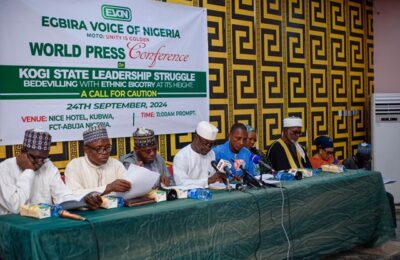The attention of the Oodua Liberation Movement (OLM) has been drawn to a write up and publication going round especially online said to be authored by one Architect George Akinola as the purported designer of the “Authentic Yoruba Flag.”
The OLM would ordinarily have ignored the publications and tag it as inoffensive; but the sequential history and framework of the Yoruba race in her determination for an autonomous nation cannot be toyed with, or left to be distorted by self-seeking individuals, and their praise-singing collaborators.
The History of the Flag
To put the records straight, the vision, aspirations and design of the Yoruba flag as adopted at the Pan-Yoruba World Congress under the leadership of late Senator Abraham Aderibigbe Adesanya was the result of conscious mobilization and consultations across the twenty-two (22) Divisions of the Yoruba Nation. These includes: Kwara, Kogi, Delta (Itsekiri), Ondo, Ekiti, Osun, Oyo, Edo, Lagos; and Yoruba in the Diaspora.
The consultations and mobilizations which took almost three (3) years began in 1994 soon after the launch of Oodua Youth Movement (OYM) and did not end until 1998 to conclude. The consultations cut-across town unions, artisans, farmers’ groups, self-determination groups, armed forces, academia, professional groups, media practitioners, religious bodies, women groups; and virile youth vanguards.
While Akinola was a member of OLM at this time, he was not a member of the Central Working Committee (CWC) of OLM and could not have been part of the highest decision making body.
These workshops and consultations were coordinated by conscious leaders of the OLM like Rotimi Obadofin of Iya Gbede, Kogi ancestry and many others we may not wish to list at the moment. We shall refrain from mentioning the names of the living in line with the OLM tradition.
The cadres worked through days and nights. Leaders of the organization were given the responsibility to sketch a design.
The colours were carefully chosen by the OLM leadership.
RED: Represents the struggle and the blood of our heroes and heroines martyred by the injustices of the Nigerian project occasioned by the 1914 forced amalgam of several incompatible diverse nationalities by the British overlords.
GREEN: We had a tough debate on this, GREEN also being the choice of Uthman Dan Fodio who handed over the flag of conquest to his children in 1803, one year before the Jihad began. But we concluded the colour green predated the Fulani emirate and had been used by Yoruba in various ways earlier.
This showcases the fertility of the Yorubaland, environment and culture as demonstrated in agricultural prowess of our ancestors; and under the self-rule government of late sage, Chief Obafemi Awolowo to raise the economy of the Region to one of the best economies in Africa.
BLACK: The pride and colour of the modern day world civilization; and also the Yoruba as the single largest homogenous black ethnic group in the world.
Even though the harmonization of all the workshops, dialogues and consultations that eventually birthed the design was domiciled with the OLM, we cannot and will not claim ownership of the flag whose final output was done in the United States by the late Chairman of our POLIT BUREAU, Baba Omojola in one of his overseas trip.
The list is inexhaustible, but it is evidence-based to mention a few of high profile individuals and organizations that contributed to the final concept of the FLAG AND YORUBA MAP. They include: Abraham Adesanya, Pa Solanke Onasanya, a famous Yoruba retired, a famous Itsekiri woman of substance, leaders of Afenifere still living, Yoruba former Ambassador, two Yoruba professors based in the United States, late Comrade Ola Oni, late Professor Akin Fadahunsi, popular Yoruba dramatist, Aworo, late Comrade Rotimi Obadofin, late Justice Adewale Thompson and many key actors in Apapo Omo Oodua, Afenifere, Oodua Youth Movement (OYM) and other allies also contributed tremendously.
We vividly remember that part of the assignment on our journey to Ivory Coast, hosted by the late Biodun Kolawole and a Yoruba Professor was to make consultation with some of the Yoruba in that Country on a suitably agreed philosophy of a YORUBA FLAG AND MAP.
Oriolokun. This was generally accepted as having, for centuries been representing the Yoruba symbol of ancestry.
The SEVEN stars represented the seven ( 7) Royal children of Oduduwa spread across Yorubaland, Benin and Togo.
While the flag was adopted in 1998, the map of a Yoruba Country was equally designed but remains work-in-progress, as more consultations, dialogues and compromises are expected in the near future.
It is therefore, a mark of infantile revolutionary disorder for anyone to claim to have designed the Yoruba Flag and in fact a show of low esteem and self promotion which are vices a good revolutionary must avoid.
The OLM has always adopted the principle of cells; we do not believe in large mouth strategy which only seek to promote individuals and undermine the collective spirit.
We hope in setting the records straight otherwise on an issue that should not even have come into public debate, not at this time, we have been able to counsel self-righteous people in our collective struggle to seek to be modest and learn to speak less in the public domain. We still have a long way to go and it is not yet time for trophy seeking even when the game is yet to kickoff.
– Comrade Taiwo Otitolaye
For: Central Working Committee, Oodua Liberation Movement.




